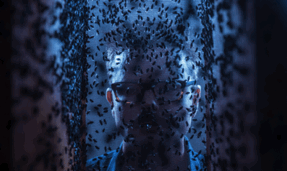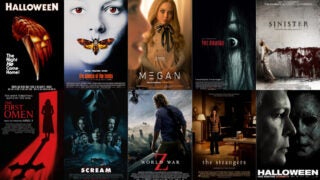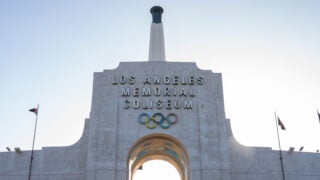John Knuth and the Art of Chaos
John Knuth MFA ’05 disrupts the natural order with flies, snakes and other collaborators from the animal kingdom.
His studio has all the hallmarks of an artist’s space. High ceilings. Exposed pipes. Paint-splattered cement floor.
And a slithering, shimmering white California kingsnake.
The serpent is a creative partner of sorts for John Knuth MFA ’05, living alongside the artist’s canvases, paints and brushes. The snake belongs to a species native to Southern California, but you’re unlikely to find a pure-white one like this on your next hiking trip. “The albinos are bred for pure aesthetics,” says the Los Angeles-based artist. “I love the idea of an animal that exists outside of nature.”
This tension between nature and civilization inspires much of Knuth’s art, which is known for capturing the raw, uncertain moments when the natural order is disrupted.
As an undergraduate at the University of Minnesota, Knuth studied these moments by creating disruptive events, then documenting people’s reactions. “I was always doing weird performance things,” he remembers. “Making planes out of smoke bombs and throwing them over the Mississippi River.” He was also studying his own reactions to the events: the anxiety he’d feel beforehand, the recklessness of creating a public spectacle without a pre-determined ending. “I’d get nervous doing these kinds of uncontrolled, un-private things,” he says. “There’s a lot of chance…of push and pull and control and lack of control.”
Slither and Buzz
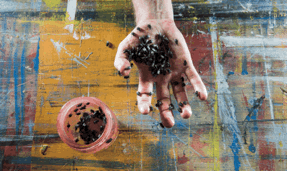
Then there are his other creative partners from the animal kingdom. Their handiwork spans a wall of Knuth’s Mid-City studio—just a few miles from the University Park Campus—in the form of three 7-foot-by-3-foot canvases.
Named “Station Dispersion” after the 2009 wildfire that decimated 160,000 acres in the mountains north of Los Angeles, the triptych captures what happens when civilization encroaches on nature.
From a distance, the paintings erupt in gorgeous Rothko-esque bands of color, monochromatic yet varying in intensity and density. Smoke starts on the top left canvas, its grayish-white plumes floating over red flames. The middle canvas shows the intensity of heat as the fire bursts with thick orange flares and glowing embers. The final canvas represents a sooty aftermath, with greasy, smoldering grays and greens spiraling into blackness. “The disaster of the megalopolis,” Knuth calls it.
The paintings are the latest in Knuth’s “Fly Series,” named for a technique he developed as a graduate student at the USC Roski School of Art and Design. Yes, he uses flies—hundreds of thousands of them—nurturing many generations from maggot to pupa to fly. He traps them inside a mesh tent attached to a canvas and feeds them a mixture of sugar, water and paint pigments. Over six weeks, generations of flies regurgitate on the canvas, resulting in millions of minuscule specks of color. As you back away, the tiny dots dissolve into richly textured paintings.
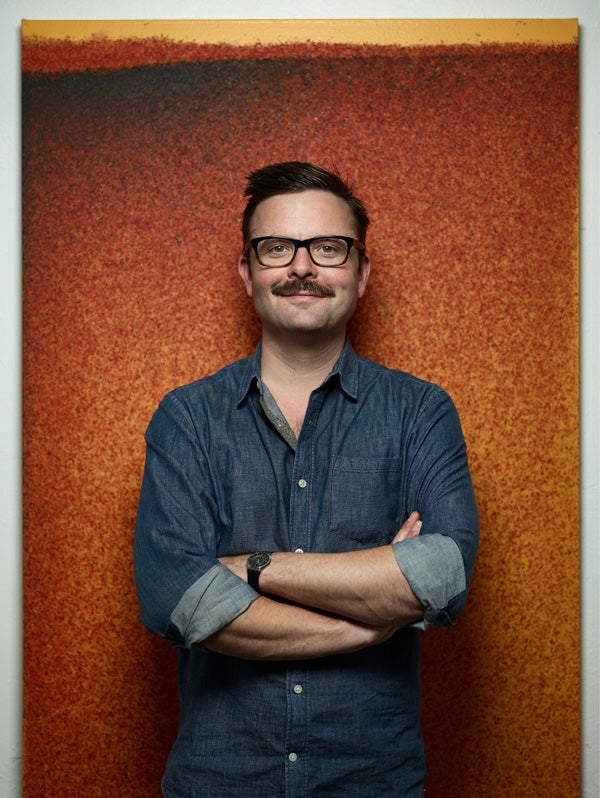
Chaos Amid Calm
As unconventional as the technique sounds, the Fly Series is in keeping with Knuth’s need to push the lines between control and chaos. As with his genetically tweaked snake, the flies—which are non-social insects—enter an existence that would never happen in nature. The series is about “manipulating the physical properties of the fly to create something outside of its existence,” he says. And while Knuth stresses the intentional thought and planning behind each composition, ultimately he relinquishes control to the flies. In this uncharted landscape, the marks they leave are still unpredictable.
Now Knuth wants to “go bigger.” He plans to experiment with different colors, densities, and complexities. “You can see within all my work that it’s an ongoing process,” he says. “You see where an idea starts and becomes more complicated, and how it leads to another idea.”
As for his message? While Knuth isn’t entirely comfortable with the notion of art as a messenger, he does feel the need to express himself. “A lot of the things I’m interested in come from my dissatisfaction with the world around me that I want to change or reflect,” he says. If he did have a message, it would be to question the natural order and push back against the status quo. “It’s fun to get weird out there,” he says. “When you do unusual things in a place that’s not designed for it, it turns people on.”

